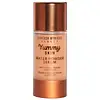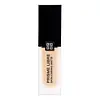Danessa Myricks Beauty Yummy Skin Water Powder Serum Versus Givenchy Prisme Libre Skin-Caring Matte Foundation
What's inside
What's inside
 Key Ingredients
Key Ingredients

 Benefits
Benefits

 Concerns
Concerns

 Ingredients Side-by-side
Ingredients Side-by-side

Water
Skin ConditioningSilica
AbrasivePropanediol
SolventGlycerin
HumectantPyrus Malus Fruit Extract
Skin ConditioningHyaluronic Acid
HumectantKaolin
AbrasiveNiacinamide
SmoothingZinc PCA
HumectantSqualane
EmollientTremella Fuciformis Extract
HumectantGluconolactone
Skin ConditioningGalactoarabinan
Calcium Gluconate
HumectantPolyacrylate Crosspolymer-6
Emulsion StabilisingPotassium Sorbate
PreservativeEthylhexylglycerin
Skin ConditioningSodium Benzoate
MaskingAlumina
AbrasiveCI 77891
Cosmetic ColorantCI 77491
Cosmetic ColorantWater, Silica, Propanediol, Glycerin, Pyrus Malus Fruit Extract, Hyaluronic Acid, Kaolin, Niacinamide, Zinc PCA, Squalane, Tremella Fuciformis Extract, Gluconolactone, Galactoarabinan, Calcium Gluconate, Polyacrylate Crosspolymer-6, Potassium Sorbate, Ethylhexylglycerin, Sodium Benzoate, Alumina, CI 77891, CI 77491
Water
Skin ConditioningC9-12 Alkane
SolventCaprylic/Capric Triglyceride
MaskingPropanediol
SolventSilica
AbrasiveAlcohol
AntimicrobialCoco-Caprylate/Caprate
EmollientSorbitan Sesquiisostearate
EmulsifyingPentylene Glycol
Skin ConditioningPullulan
Stearalkonium Hectorite
Gel FormingTrimethylsiloxysilicate
EmollientPolyglyceryl-3 Polyricinoleate
EmulsifyingPolyglyceryl-3 Diisostearate
EmulsifyingSodium Myristoyl Glutamate
CleansingSodium Chloride
MaskingHydroxyacetophenone
AntioxidantParfum
MaskingPotassium Sorbate
PreservativeMaltodextrin
AbsorbentBixa Orellana Seed Extract
MaskingTropaeolum Majus Flower/Leaf/Stem Extract
Skin ConditioningAluminum Hydroxide
EmollientKaolin
AbrasivePolyhydroxystearic Acid
EmulsifyingTocopherol
AntioxidantSynthetic Fluorphlogopite
1,2-Hexanediol
Skin ConditioningCaprylyl Glycol
EmollientIllite
AbrasiveIsostearic Acid
CleansingLecithin
EmollientCitric Acid
BufferingTin Oxide
AbrasiveCI 77891
Cosmetic ColorantCI 77491
Cosmetic ColorantCI 77492
Cosmetic ColorantCI 77499
Cosmetic ColorantWater, C9-12 Alkane, Caprylic/Capric Triglyceride, Propanediol, Silica, Alcohol, Coco-Caprylate/Caprate, Sorbitan Sesquiisostearate, Pentylene Glycol, Pullulan, Stearalkonium Hectorite, Trimethylsiloxysilicate, Polyglyceryl-3 Polyricinoleate, Polyglyceryl-3 Diisostearate, Sodium Myristoyl Glutamate, Sodium Chloride, Hydroxyacetophenone, Parfum, Potassium Sorbate, Maltodextrin, Bixa Orellana Seed Extract, Tropaeolum Majus Flower/Leaf/Stem Extract, Aluminum Hydroxide, Kaolin, Polyhydroxystearic Acid, Tocopherol, Synthetic Fluorphlogopite, 1,2-Hexanediol, Caprylyl Glycol, Illite, Isostearic Acid, Lecithin, Citric Acid, Tin Oxide, CI 77891, CI 77491, CI 77492, CI 77499
Ingredients Explained
These ingredients are found in both products.
Ingredients higher up in an ingredient list are typically present in a larger amount.
Ci 77491 is also hydrated iron III oxide. It's sole purpose is to give a red/pink hue to products.
Iron III oxides are classified as inorganic chemicals for coloring.
Synthetically created Ci 77491 is considered safer than those naturally found. This is because the synthetically created version may contain less impurities. Iron oxides are generally non-toxic and non-allergenic.
Learn more about CI 77491Ci 77891 is a white pigment from Titanium dioxide. It is naturally found in minerals such as rutile and ilmenite.
It's main function is to add a white color to cosmetics. It can also be mixed with other colors to create different shades.
Ci 77891 is commonly found in sunscreens due to its ability to block UV rays.
Learn more about CI 77891Kaolin is a clay. It is used for oil control and to help minimize pores. Like other clays, kaolin has the ability to absorb excess sebum or oil. This can help clean out pores and mattify the skin.
Some types of kaolin may have exfoliating properties. When water is added to kaolin, it becomes a paste with small abrasive particles.
Most kaolin is a white color, but may be pink/orange/red depending on where it comes from.
The name 'kaolin' comes from a Chinese village named 'Gaoling'. Kaolin clay comes from rocks rich in kaolinite. Kaolinite, the mineral, has a silicate layered structure. Kaolinite is formed from chemical weathering of aluminum siilicate minerals.
Besides skincare, kaolin is commonly used to make glossy paper, in ceramics, toothpaste, and as medicine to soothe stomach issues.
Learn more about KaolinPotassium Sorbate is a preservative used to prevent yeast and mold in products. It is commonly found in both cosmetic and food products.
This ingredient comes from potassium salt derived from sorbic acid. Sorbic acid is a natural antibiotic and effective against fungus.
Both potassium sorbate and sorbic acid can be found in baked goods, cheeses, dried meats, dried fruit, ice cream, pickles, wine, yogurt, and more.
You'll often find this ingredient used with other preservatives.
Learn more about Potassium SorbatePropanediol is an all-star ingredient. It softens, hydrates, and smooths the skin.
It’s often used to:
Propanediol is not likely to cause sensitivity and considered safe to use. It is derived from corn or petroleum with a clear color and no scent.
Learn more about PropanediolSilica, also known as silicon dioxide, is a naturally occurring mineral. It is used as a fine, spherical, and porous powder in cosmetics.
Though it has exfoliant properties, the function of silica varies depending on the product.
The unique structure of silica enhances the spreadability and adds smoothness, making it a great texture enhancer.
It is also used as an active carrier, emulsifier, and mattifier due to its ability to absorb excess oil.
In some products, tiny microneedles called spicules are made from silica or hydrolyzed sponge. When you rub them in, they lightly polish away dead skin layers and enhance the penetration of active ingredients.
Learn more about SilicaWater. It's the most common cosmetic ingredient of all. You'll usually see it at the top of ingredient lists, meaning that it makes up the largest part of the product.
So why is it so popular? Water most often acts as a solvent - this means that it helps dissolve other ingredients into the formulation.
You'll also recognize water as that liquid we all need to stay alive. If you see this, drink a glass of water. Stay hydrated!
Learn more about Water